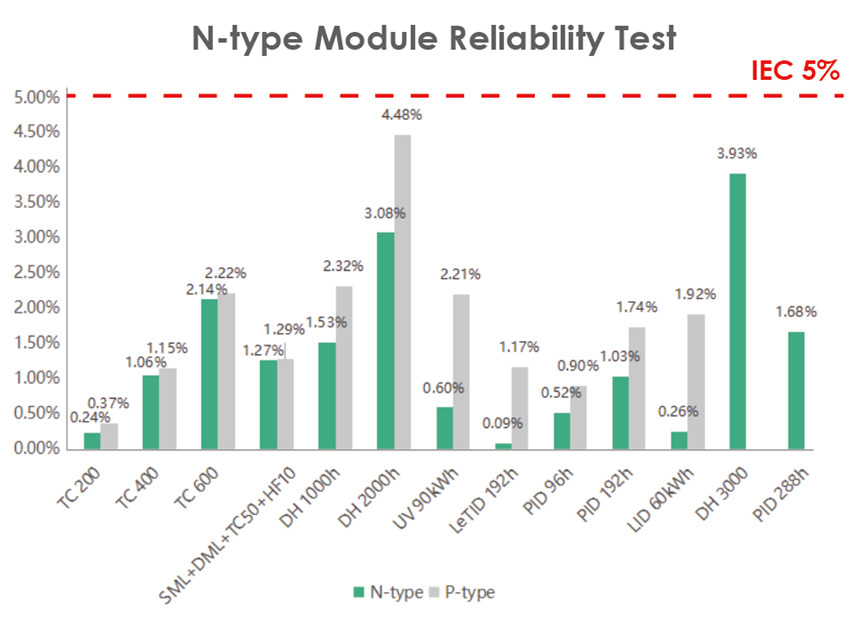The vulnerability of PERC modules to LID and LeTID is well known and among the reasons the industry is moving towards N-type technology, which tends to be less affected by the two phenomena. TUV Nord has carried out comparative testing on a conventional PERC module and a JinkoSolar N-type TOPCon module in order to study their respective degradation rates.
The test results revealed that the LID of the JinkoSolar TOPCon module was only 0.26% after exposure of 60KWh/m2, while the degradation of the PERC equivalent is 1.92% under the same conditions. LeTID testing over 192 hours revealed N-type power degradation to be 0.09% in comparison to 1.17% for P-type.
Reliability Test Method:
1. Accelerated-aged degradation tests were performed on N-type TOPCon panels: thermal cycling TC 200 (defined in IEC 61215: 200 cycles, temperature limits of -40°C and +85°C) 400/600; extended damp heat testing – DH 1000 (defined in IEC 61215 at a temperature of 85°C and a relative humidity of 85%) 2000/3000; mechanical strength sequence (static mechanical load, dynamic mechanical load, thermal cycling, humidity freeze) SML+DML+TC50+HF10; accelerated ultraviolet UV 90 stress testing.
2. LID 60kWh and LeTID 192h tests were performed on N-type TOPCon panels: LID 60kWh, (modules undergoing outdoor light soaking until stabilization of LID as defined by IEC 63202-1: > 20kWh); LeTID testing for 192 hours, modules placed in an environmental chamber at 75°C while connected to a power supply and injected with a low current. The use of a low current is equivalent to the module operating in full sun at maximum power point. Characterization: IV flash testing to measure power loss, visual inspection and wet leakage testing to ensure that power loss can be attributed to LeTID, EL testing to show the visual signature of LeTID.
3. PID tests were performed on N-type TOPCon panels: PID 96(IEC 61215) 192/288

Test Results:
As shown in the graphic above, the power degradation of the JinkoSolar N-type module is significantly lower than P-type in various IEC standard aging tests, and key items such as TC, PID and DH have all passed multiple strict tests.
The LID of the JinkoSolar module is only 0.26% after exposure of 60KWh/m2, while the degradation of the conventional PERC module is 1.92% under the same conditions. After LeTID testing of 192 hours, the power of the N-type module is degraded by 0.09%, whereas the figure for the P-type module is 1.17%.
Conclusions:
The results fully validate the high reliability of JinkoSolar’s N-type product, which has lower LID and LeTID than the PERC module due to its high efficiency cell technology and high-quality n-type silicon wafer, which not only eliminates the LID caused by B-O complex defects, but also has a higher minority carrier lifetime. In addition, the results also confirm that JinkoSolar’s N-type modules have excellent aging- and PID-resistant properties, due to the adoption of a premium quality aluminium frame, glass and POE encapsulant, enhancing the mechanical and anti-vapour-penetration property.
The UV test was performed on N-type and P-type modules with UV irradiation of 90KWh/m2. The degradation of module power was 0.60% and 2.21% respectively, with quality of appearance unaffected.
